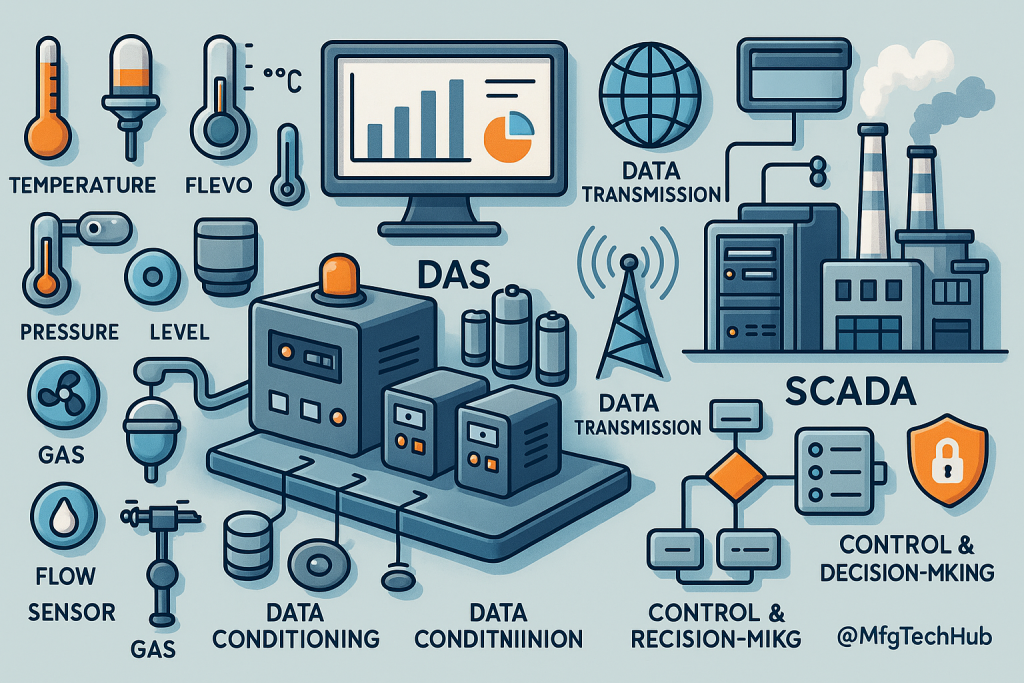SCADA Systems Components: Data Acquisition & Sensors 🚀

1. Introduction to Data Acquisition in SCADA
SCADA systems rely on real-time data acquisition to monitor, analyze, and control industrial processes. The accuracy of SCADA decisions depends on how effectively data is collected from the field.
📌 Example: A SCADA system in a power plant continuously collects temperature, voltage, and pressure data from turbines to optimize performance and prevent failures.
🔹 Why is Data Acquisition Important?
✅ Provides real-time process monitoring for industrial automation.
✅ Ensures accurate system control by analyzing live data.
✅ Supports predictive maintenance by detecting anomalies.
✅ Enhances safety and efficiency in critical infrastructure.
2. Key Components of SCADA Data Acquisition
Data acquisition in SCADA involves multiple hardware and software components, working together to collect, process, and transmit data.
A. Sensors & Field Devices
🔍 Function: Measure physical parameters such as temperature, pressure, flow, level, and vibration.
💡 Example: A temperature sensor in a boiler monitors heat levels, sending data to SCADA for real-time adjustments.
B. Signal Conditioning Units
🔗 Function: Convert raw sensor data into a readable format for SCADA systems.
💡 Example: An analog temperature sensor’s voltage signal is converted into digital data for SCADA analysis.
C. Data Acquisition Systems (DAS)
📡 Function: Aggregate data from multiple sensors and transmit it to SCADA computers.
💡 Example: A water treatment plant uses a DAS to collect pH, turbidity, and chlorine levels for monitoring.
D. Data Transmission Networks
📶 Function: Transfers acquired data to SCADA via wired or wireless networks.
💡 Example: Modbus TCP/IP and OPC UA are commonly used to transmit SCADA data.
E. SCADA Servers & Databases
🖥 Function: Process, store, and visualize acquired data for real-time decision-making.
💡 Example: A SCADA dashboard displays live data trends, alarm notifications, and historical analysis.
3. Types of Sensors Used in SCADA Data Acquisition
SCADA systems utilize various types of sensors depending on industry applications.
| Sensor Type | Function | Industry Application |
|---|---|---|
| Temperature Sensors | Measure heat levels in equipment and processes. | Power plants, HVAC, food processing |
| Pressure Sensors | Detect pressure variations in pipelines and tanks. | Oil & gas, chemical plants, water distribution |
| Flow Sensors | Monitor fluid or gas movement in pipes. | Water treatment, oil & gas pipelines |
| Level Sensors | Measure liquid levels in tanks and reservoirs. | Water utilities, chemical plants |
| Vibration Sensors | Detect mechanical vibrations in machines. | Manufacturing, predictive maintenance |
| Gas Sensors | Identify gas leaks and air quality issues. | Oil refineries, HVAC, mining |
🔹 Example: A water distribution SCADA system uses flow sensors to detect leaks and optimize water supply.
4. How Data Acquisition Works in SCADA Systems
The data acquisition process in SCADA systems follows a structured workflow:
Step 1: Data Collection
📌 Sensors measure physical parameters like temperature, flow, and pressure.
Step 2: Signal Conditioning
📌 Raw sensor signals are filtered and converted into a usable digital format.
Step 3: Data Transmission
📌 The data is transmitted via wired or wireless networks to SCADA servers.
Step 4: Data Processing & Storage
📌 SCADA software analyzes, logs, and visualizes the acquired data.
Step 5: Control & Decision-Making
📌 SCADA adjusts system parameters based on data trends and alerts operators.
5. Advancements in SCADA Data Acquisition
Modern SCADA data acquisition is evolving with new technologies, improving accuracy, speed, and security.
A. IoT & Smart Sensors
🖥 Real-time connectivity & cloud integration for automated industrial monitoring.
💡 Example: IoT-based smart sensors monitor air quality in smart cities.
B. AI & Machine Learning in Data Analytics
📊 Predictive analytics for fault detection & process optimization.
💡 Example: AI-based SCADA predicts pump failures in wastewater treatment plants.
C. Edge Computing for Faster Processing
🛠 Processing sensor data at the edge reduces latency and network congestion.
💡 Example: Edge-based SCADA in oil rigs analyzes well pressure locally, reducing data transmission costs.
D. Cybersecurity for Data Acquisition
🛡 Encryption & secure authentication protect SCADA data from cyber threats.
💡 Example: A power grid SCADA system implements AES-256 encryption to prevent data breaches.
6. Cybersecurity Challenges in SCADA Data Acquisition
🚨 SCADA sensors are prime targets for cyber threats, requiring strict security measures.
A. Common Security Threats
🔍 Sensor Tampering – Hackers manipulate data to cause process failures.
🦠 Malware Attacks – Malicious software alters data acquisition processes.
🚫 Denial-of-Service (DoS) Attacks – Attackers flood SCADA networks, disrupting real-time data.
B. Best Practices for Securing SCADA Data Acquisition
✅ Use Encrypted Communication: Secure sensor data with SSL/TLS encryption.
✅ Enable Multi-Layer Authentication: Restrict unauthorized access to data acquisition systems.
✅ Deploy AI-Powered Intrusion Detection: Identify anomalous sensor activity in real time.
✅ Conduct Regular Security Audits: Test for vulnerabilities in SCADA data collection systems.
🔹 Example: A chemical plant SCADA system adopted encrypted data acquisition, preventing unauthorized sensor modifications.
7. Case Study: SCADA Data Acquisition in Smart Water Management
Problem:
A municipal water utility faced high water wastage due to leaks and pipeline failures.
Solution:
🔹 Deployed smart flow & pressure sensors for real-time monitoring.
🔹 Integrated AI-based data analysis for leak detection.
🔹 Upgraded SCADA communication networks for instant alerts.
Outcome:
✅ Reduced water loss by 35% through automated leak detection.
✅ Optimized pump control, lowering energy consumption by 20%.
✅ Improved service reliability, ensuring consistent water supply.
SCADA data acquisition and sensors form the foundation of industrial automation, enabling accurate monitoring, predictive maintenance, and process optimization. With advancements in IoT, AI, edge computing, and cybersecurity, SCADA data acquisition is becoming more efficient, intelligent, and secure.
